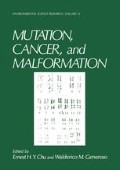Summary
In 61 laboratories using a variety of prokaryotic and eukaryotic short-term assays a maximum of 42 chemicals were tested. The purpose of the study was to identify the best battery of assays for screening carcinogens. None of the assay systems correctly identified all the proven carcinogens or “noncarcinogens”. The individual assays were characterized by sensitivity (% of correct identification of carcinogens), specificity (% of correct identification of “noncarcinogens”), predictivity (% of carcinogens correctly identified among all the compounds tested) and hypersensitivity (% of compounds classified as carcinogens among all the compounds tested.
Access this chapter
Tax calculation will be finalised at checkout
Purchases are for personal use only
Preview
Unable to display preview. Download preview PDF.
References
Ashby, J. , P. A. Lefevre, B. M. Elliott, and J. A. Styles (1982) An overview of the chemical and biological reactivity of 4CMB and structurally related compounds: Possible relevance to the overall findings of the UKEMS 1981 study.Mutation Res. 100: 417 – 433.
Ashby, J. , and D. Paton (1981) Selection, preparation, and purity of the test chemicals, pp. 8–15, in ref. no. 7.
Auerbach, C. , and J. M. Robson (1944) Production of mutation by allyl isothiocyanate.Nature154: 81 – 82.
Boveri, T. (1929)The Origin of Malignant Tumors,. Williams and Wilkins, Baltimore, Maryland.
Burdette, W. J. (1955) The significance of mutation in relation to the origin of tumors: A review.Cancer Res. 15: 201 – 226.
Cooper, J. A. , II, R. Saracci, and P. Cole (1979) Describing the validity of carcinogen screening tests.Br. J. Cancer39: 87 – 89.
de Serres, F. J. , and J. Ashby, Eds. (1981)Evaluation of Short-Term Tests for Carcinogens. Report of the International Collaborative Program. Elsevier/North Holland, New York.
Hodes, L. (1981) Computer-aided selection of compounds for antitumor screening: Validation of a statistical-heuristic method.J. Chem. Inf. Comput. Sci. 21: 128 – 132.
Hollaender, A. , Ed. ( 1971 on)Chemical Mutagens.Principles and Methods for Their Detection. Plenum, New York.
Maugh, T. H. (1983) How many chemicals are there?Science199: 162.
Maugh, T. H. (1983) Hew many chemicals are there?Science220: 293.
Plewa, M. J. (1978) Activation of chemicals into mutagens by green plants: A preliminary discussion.Env. Health Persp. 27: 45 – 50.
Plewa, M. J. , D. L. Weaver, L. C. Blair, and J. M. Gentile (1983) Activation of 2-aminofluorene by cultured plant cells.Science219: 1427 – 1429.
Purchase, I. F. H. (1980) Inter-species comparison of carcinogenicity.Br. J. Cancer41: 454 – 468.
Purchase, I. F. H. (1982) An appraisal of predictive tests for carcinogenicity.Mutation Res. 99: 53 – 71.
Redei, G. P. (1982) Gene number estimates based on mutation frequencies inArabidopsis. Genetics100, Suppl. 1, Pt. 2, s56 – s57.
Redei, G. P. , M. M. Redei, W. R. Lcwer, and S. Sandhu (1980) Identification of carcinogens by mutagenicity forArabidopsis. Mutation Res. 74: 469 – 475.
Robertson, M. (1983) What happens when cellular oncogenes collide with immunoglobulin genes.Nature302: 474 – 475.
Scherr, G. H. , M. Fishman, and R. H. Weaver (1954) The mutagenicity of some carcinogenic compounds forEscherichia coli. Genetics39: 141 – 149.
Selkirk, J. K. , and M. C. MacLeod (1982) Chemical carcinogenesis: Nature’s metabolic mistake.Bioscience32: 601 – 605.
Stich, H. F. A. , and R. H. C. San, Eds. (1981)Short-Term Tests for Chemical Carcinogens, Springer-Verlag, New York.
Streisinger, G. (1983) Extrapolations from species to species and from various cell types in assessing risks from chemical mutagens.Mutation Res. 114: 93 – 105.
Tomatis, L. , C. Agthe, H. Bartsch, J. Huff, R. Montesano, R. Saracci, E. Vklker, and J. Wilbourn (1978) Evaluation of carcinogenicity of chemicals: A review of the monograph program of the International Agency for Research on Cancer (1971–1977).Cancer Res, 38: 877 - 885.
Weisburger, J. H. , and G. M. Williams (1980) Chemical carcinogens, inCasarett and Doull1s Toxicology, J. Doull, C. D. Klaassen, and M. O. Amdur, Eds. /Macmillan, New York, pp. 84 – 138.
Wildeman/ A. G. /and R. N. Nazar (1982) Significance of plant metabolism in the mutagenicity and toxicity of pesticides.Can. J. Genet. Cytol. 24: 437 – 449.
Wright, A. S. (1980) The role of metabolism in chemical mutagenesis and chemical carcinogenesis.Mutation Res. 75: 215 – 241.
Author information
Authors and Affiliations
Editor information
Editors and Affiliations
Rights and permissions
Copyright information
© 1984 Plenum Press, New York
About this chapter
Cite this chapter
Rédei, G.P., Acedo, G.N., Sandhu, S.S. (1984). Sensitivity, Specificity and Accuracy of the Arabidopsis Assay in the Identification of Carcinogens. In: Chu, E.H.Y., Generoso, W.M. (eds) Mutation, Cancer, and Malformation. Environmental Science Research, vol 31. Springer, Boston, MA. https://doi.org/10.1007/978-1-4613-2399-0_30
Download citation
DOI: https://doi.org/10.1007/978-1-4613-2399-0_30
Publisher Name: Springer, Boston, MA
Print ISBN: 978-1-4612-9463-4
Online ISBN: 978-1-4613-2399-0
eBook Packages: Springer Book Archive

